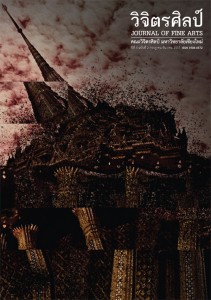อิทธิพลของปัญญาสชาดกที่มีต่อพุทธศิลปกรรมในเขตพุทธสถาน : กรณีศึกษาวัดในอำเภอเมืองเชียงใหม่
Main Article Content
Abstract
วิทยานิพนธ์ เรื่อง “อิทธิพลของปัญญาสชาดกที่มีต่อพุทธศิลปกรรมใน เขตพุทธสถาน: กรณีศึกษาวัดในอำเภอเมืองเชียงใหม่” ประกอบด้วย วัตถุประสงค์ทางการศึกษา 3 ข้อ คือ
1) เพื่อศึกษากำเนิดและพัฒนาการของปัญญาสชาดก
2) เพื่อศึกษาอิทธิพลของปัญญาสชาดกที่มีต่อพุทธศิลปกรรมในเขตพุทธสถาน อำเภอเมืองเชียงใหม่
3) เพื่อศึกษาบทบาทของศิลปินในการสืบทอดผลงานพุทธศิลปกรรมที่ได้รับ อิทธิพลจากปัญญาสชาดก
“ปัญญาสชาดก” เป็นผลงานวรรณกรรมเก่าแก่ทางพระพุทธศาสนา โดยผ่านการรจนาของภิกษุสงฆ์เมืองเชียงใหม่ (ล้านนา) เมื่อประมาณ พ.ศ. 2000 – 2200 ต่อมาเป็นจุดกำเนิดผลงานศิลปะชั้นครูมากมาย เมื่อเปิดเผยความจริงให้เราสัมผัส ไม่ว่าความจริงเฉพาะหรือความจริงอันสากล มักก่อให้เกิดแรงบันดาลใจที่จะทำสิ่งดีงาม เรื่องราวบางเรื่องภายในคัมภีร์นี้ถ่ายทอดโศกนาฏกรรมของพระโพธิสัตว์ได้อย่างสะเทือนใจและซาบซึ้งตรึงใจให้กับผู้รู้ ผู้ฟัง ผู้อ่านเข้าถึงผัสสะภายใน นอกจากความงามและอรรถรสของเนื้อเรื่องแล้ว ผลงานวรรณกรรมจากปัญญาสชาดกยังมีลักษณะโดดเด่นเฉพาะตัวในรูปแบบชาดกนอกนิบาต กล่าวคือสามารถเป็นสื่อกระตุ้นให้ชาวสยามประเทศในยุคสมัยนั้นและยุคต่อๆมา ก่อประโยชน์สร้างผลงานของแต่ละท้องถิ่นขยายตัวจากเนื้อเรื่องภายในคัมภีร์ปัญญาสชาดกออกไปในวงกว้าง โดยไม่ได้มุ่งเน้นเรื่องขอบเขตดินแดนราชอาณาจักร หากคงคุณค่าของขอบเขตความดีงามทางพระพุทธศาสนา มุ่งเป็นสื่อให้แก่ชาวสากลโลกได้รับรู้
อิทธิพลของคัมภีร์ปัญญาสชาดกที่มีต่อพุทธศิลปกรรมในเขตพุทธสถานอำเภอเมืองเชียงใหม่ พบว่าคำสอนในคัมภีร์ปัญญาสชาดกถูกแปลงออกมาเป็นพุทธศิลปกรรมในรูปแบบต่างๆ เช่น งานจิตรกรรมฝาผนังภายในวิหารลายคำ วัดพระสิงห์วรมหาวิหาร งานจิตรกรรมฝาผนังบนหอไตร วัดช่างฆ้องและงานประติมากรรมฝาผนัง (ปูนปั้น) ภายนอกอุโบสถหลังเก่า วัดอู่ทรายคำเป็นต้น ในอดีต พุทธศิลปกรรมชั้นเลิศจากปัญญาสชาดกที่มีอยู่ภายในเขตพุทธสถาน อำเภอเมืองเชียงใหม่นั้น มุ่งถ่ายทอดอุดมคติแอบแฝงวิถีชีวิตของคนเมืองนั้นๆ ลงไปในใจของผู้คนท้องถิ่นและนักท่องเที่ยวต่างเมืองได้ยึดถือเป็นจุดหมายสูงส่งของชีวิต ผู้ใดที่พินิจผลงานเหล่านี้ด้วยใจที่ใคร่ครวญ ย่อมตระหนักชัดว่า สิ่งที่พึงยึดถือเป็นอุดมคติของชีวิตนี้ก็คือการบ่มเพาะปัญญาและกรุณาให้เจริญมั่นคงในใจ อย่างไรก็ตาม พุทธศิลปกรรมมิได้น้อมนำจิตใจให้เข้าถึงความดีและความจริงโดยผ่านการเสพเท่านั้น การสร้างสรรค์ศิลปะก็เป็นอีกหนทางหนึ่งที่นำพาผู้คนบรรลุถึงความดีและความจริงได้ ดังนั้นช่างที่สรรค์สร้างพุทธศิลป์ในอดีตจึงอุทิศตนให้กับงานของตนอย่างเต็มที่ โดยไม่คิดจะจารึกชื่อไว้ในนฤมิตกรรมเหล่านั้นเพื่อให้โลกหรือคนรุ่นหลังรู้จักเลย
บทบาทของศิลปินท้องถิ่นแห่งสยามประเทศในอนาคตต้องตระหนักถึงคุณพระพุทธศาสนาเป็นหลัก ถือเป็นตัวแทนของบุคคลที่พัฒนาตนจนถึงอุตมภาวะอย่างเต็มศักยภาพแห่งความเป็นมนุษย์เพราะนอกจากการบำเพ็ญประโยชน์เพื่อส่วนรวมแล้ว การสร้างสรรค์พุทธศิลปกรรมยังเป็นวิถีแห่งการฝึกฝนพัฒนาตนด้วย ช่างสมัยก่อนไม่เพียงถือศีล บำเพ็ญพรต และเจริญสมาธิก่อนสร้างสรรค์ผลงานที่เป็นพุทธศิลป์เท่านั้น หากยังอาศัยงานศิลปะนั้นเป็นเครื่องฝึกจิตไปด้วย เช่น น้อมใจให้มีสมาธิหรือฝึกจิตให้เป็นหนึ่งเดียวกับธรรมชาติ ในพุทธศาสนาแบบเซน นักปฏิบัติบางคนวาดต้นไผ่นานนับสิบปีเพื่อเป็นหนึ่งเดียวกับต้นไผ่ และในที่สุดก็ไม่มีแม้กระทั่งความสำนึกว่าตนเป็นหนึ่งเดียวกับต้นไผ่ ถึงตรงนี้ผลงานพุทธศิลปกรรมจากปัญญาสชาดกจะเป็นอย่างไรไม่สำคัญ เท่ากับสภาวะหรือภูมิจิตของผู้วาด มองในแง่นี้การทำงานพุทธศิลปกรรมจึงมิใช่อะไรอื่น หากคือการปฏิบัติธรรมนั่นเอง
An Influence of Paññāsajātaka on Buddhist Fine Arts in Buddhist Places : A Case Study of Muang District Chiang Mai Province
This an influence of Paññāsajātaka on Buddhist fine arts in Buddhist places : a case study of Muang district Chaing Mai province. Including educational objectives are following by three items.
1) To study the origin and development of Paññāsajātaka
2) To study the influence of on Buddhist fine arts in Buddhist places of Muang Chiangmai district.
3) To study the role of successful artists in Buddhist art works that have been influenced by Paññāsajātaka.
The study found that the book was written by Lanna monks around the year 2000 - 2200 B.C. Later it origin many of the arts classify. When the fact was revealed to the world, both particular truth and universal truth causes the inspiration to do something good. Some stories about the book itself are tragedy of the Bodhisattva with depression. Impressive taking their audience to the point that can direct access to sensitivity. Besides the beauty and taste of the story that talk about the Bodhisattva in animal models outside Nibat. (The Paññāsajātaka which is not appeared in the Collection). The book can be the media urging Siamese in that era and later generations to benefit creating local grew of the scripture out to the wider society without focusing on borders of the Kingdom. The aim is to only keep the value of the good in Buddhist religion and bring out to the worlds to be known.
The influence from the book has been converted into Buddhist fine arts form such as painting murals inside the temple of Lai Kham in Wat Pra Singha Woramahawiharn, the painting mural on the Hotrai in Wat Chang Gong, Low relief sculpture wall (stucco) outside the old chapel in Wat U Sai Kham etc.. In the past the finest of those stories on Buddhist arts existing within the Buddhist area in Chiang Mai province ideally aim to relay the lifestyle of people in the town into the minds of the local people and tourists to upheld a noble goal of life. Whoever has studied these works with the mind consider and realized clearly whatever upheld as the ideal of life is to nurture wisdom growth and earn the security in mind. However, Buddhist fine arts did not leads the mind to reach a good and true through the art only. Artistic creation is another way to bring people achieve a good and true meaning of life. The technicians who create Buddhist art in the past are fully devoted their work. They create arts without the thought of inscribing their names in the karma world, or future generations know.
The role of local artists of Thailand in the future must conscious on influenced from religion. Considered as individuals representative to develop their fullest potential UTAMA of the human conditional and also to benefit to public. The creation of Buddhist art is also a way of developing their own practice. Artists in early years practiced tocsin together with meditation before creating a piece of Buddhist art. Buddhist arts are ways to practice our mind to concentrate or spiritual practice to be one with nature. In Zen Buddhism, some practitioners draw bamboo for ten years to become one with the bamboo. And in the end it does not even realize that they are one with the bamboo. At this point of Paññāsajātaka on Buddhist fine arts would not be as important as the conditions or mental state of the artists. In this sense it is nothing about the work of Buddhist art. It is to practice the philosophy of the Buddhism.


